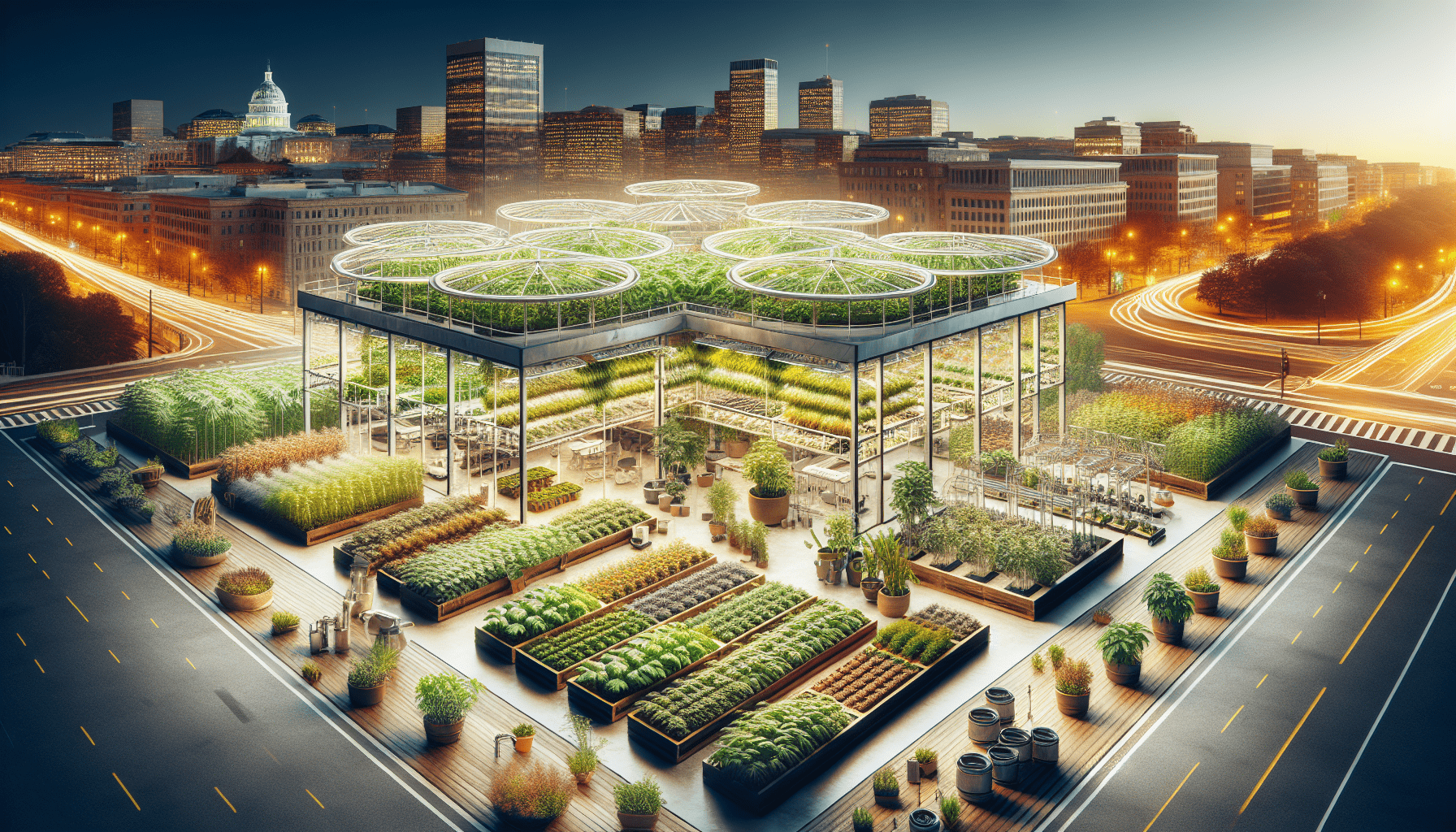Thinking about starting a commercial or personal grow in Washington, D.C.? Look no further, as this article will provide you with all the information you need to get started. Whether you’re planning to cultivate cannabis for commercial purposes or simply want to grow a few plants for personal use, we’ve got you covered. From understanding the legal requirements to selecting the right space and equipment, we’ll walk you through each step of the process in a friendly and informative manner. So, let’s embark on this exciting journey together and discover how you can successfully start your own cannabis grow in the vibrant city of Washington, D.C.!
Understanding the Current Laws and Regulations
Researching the legal requirements for commercial and personal grows
Before starting a commercial or personal grow in Washington, D.C., it is essential to thoroughly research and understand the legal requirements. Familiarize yourself with the specific laws and regulations set forth by the District of Columbia Department of Health’s Medical Marijuana Program and the D.C. Municipal Regulations. These regulations determine the eligibility criteria, cultivation limits, and licensing process for growers.
Knowing the restrictions on location and size of the grow operation
When planning your grow operation, it is crucial to be aware of the restrictions on location and size. The District of Columbia has specific zoning regulations that dictate where cannabis cultivation is permitted. Ensure that your chosen location complies with these zoning regulations, as violating them can lead to penalties or even closure of your operation. Additionally, familiarize yourself with the size limits for personal and commercial grows to ensure compliance.
Understanding licensing and permitting processes
Obtaining the necessary licenses and permits is a fundamental step in starting a legal grow operation in Washington, D.C. Research the licensing requirements for both commercial and personal grows, including the application process, fees, and deadlines. Understanding these processes will help you navigate the system more efficiently and avoid any delays or complications in obtaining the necessary approvals.
Considering zoning and land use regulations
Zoning and land use regulations play a significant role in determining the location and viability of your grow operation. Be aware of the zoning classifications that allow cannabis cultivation in Washington, D.C., and assess whether your chosen property aligns with these regulations. Additionally, consider factors such as proximity to residential neighborhoods, accessibility for deliveries, and the availability of essential utilities in your decision-making process.
Creating a Business Plan
Defining the goals and objectives of the grow operation
A well-defined business plan is essential for the success of your grow operation. Start by clearly defining your goals and objectives, including your desired market position, revenue targets, and long-term growth plans. This will provide a roadmap for your business and guide your decision-making process throughout the journey.
Identifying the target market and competition
Understanding your target market is crucial for developing an effective marketing and sales strategy. Conduct market research to identify the demographics, preferences, and needs of potential customers in Washington, D.C. Additionally, analyze the competitive landscape to learn from established growers and identify opportunities to differentiate your products and services.
Developing a detailed financial plan
Creating a detailed financial plan is crucial for securing funding and ensuring the economic viability of your grow operation. Consider all the expenses involved, including property acquisition or leasing costs, equipment and supply purchases, staffing, licensing fees, marketing expenses, and maintenance. Additionally, estimate your projected revenue and cash flow, keeping in mind the pricing dynamics and demand in the market.
Outlining the operational structure
Define the operational structure of your grow operation to ensure smooth and efficient functioning. This includes roles and responsibilities, workflows, quality control measures, and standard operating procedures (SOPs). Establishing a well-defined operational structure will help you maintain consistency, ensure compliance with regulations, and foster a positive work environment.
Securing Funding
Determining the initial capital requirements
Identifying the initial capital requirements for your grow operation is a crucial step in securing funding. Assess all the costs associated with starting the operation, such as property acquisition or lease payments, equipment and supply purchases, licensing fees, and initial staffing expenses. Determine how much capital you need to cover these costs and ensure a comfortable runway for your business.
Exploring options for financing
Once you have determined your capital requirements, explore various financing options to secure the necessary funding. These options may include traditional bank loans, small business grants, private investors, or crowdfunding platforms. Research each option extensively to understand the terms, interest rates, repayment schedules, and any potential collateral requirements.
Preparing a strong business pitch
To attract investors or secure loans, it is crucial to prepare a strong business pitch that showcases the viability and potential of your grow operation. Clearly outline your value proposition, market differentiation, financial projections, and growth plans. Fully explain the impact you expect to make in the Washington, D.C. cannabis market and highlight why your operation is deserving of financial support.
Seeking investors or loans
Once you have prepared a strong business pitch, actively seek out potential investors or lending institutions. Engage with individuals or organizations that have an interest in the cannabis industry or are aligned with your business goals and values. Attend industry events, join networking groups, and leverage online platforms to connect with potential investors or capital providers.
Finding a Suitable Location
Researching available properties and their suitability
Finding a suitable location is crucial for the success of your grow operation. Research available properties in Washington, D.C. and assess their suitability. Consider factors such as size, zoning compliance, accessibility to transportation routes, proximity to markets, and availability of utilities like water and electricity. Choose a location that not only meets legal requirements but also aligns with your operational needs.
Considering factors such as zoning, accessibility, and security
Apart from meeting legal requirements, several other factors play a significant role in determining the suitability of a location. Assess the zoning regulations to ensure your operation aligns with the specific classification. Consider accessibility for deliveries and transportation of products. Additionally, prioritize security by selecting a location that allows for the implementation of proper surveillance systems and other security measures.
Evaluating the costs associated with leasing or purchasing
Leasing or purchasing a property for your grow operation involves costs beyond the initial payment. Evaluate the long-term costs associated with leasing, such as monthly rent, maintenance fees, and potential rent increases. If purchasing, calculate mortgage payments, property taxes, and potential property value appreciation. Carefully consider the financial implications of each option before making a decision.
Visiting potential locations and assessing their potential
Once you have narrowed down potential locations, it is crucial to visit them personally and assess their potential. Take note of the physical condition of the property, the layout, and the available space for cultivation. Evaluate the surrounding environment, including noise levels, proximity to residential areas, and other businesses. Trust your instincts and choose a location that feels right for your grow operation.
Obtaining Licenses and Permits
Identifying the necessary licenses for commercial and personal grows
Obtaining the necessary licenses and permits is a critical step in starting a legal grow operation in Washington, D.C. Identify the specific licenses required for both commercial and personal grows. These may include cultivation licenses, processing licenses, transportation licenses, and distribution licenses. Familiarize yourself with the different licensing types and ensure that you meet all eligibility criteria.
Understanding the application process and requirements
To successfully obtain licenses and permits, it is essential to fully understand the application process and requirements. Thoroughly review the application guidelines provided by the District of Columbia Department of Health’s Medical Marijuana Program. Ensure that you have all the required documentation, including background checks, financial statements, and security plans, prepared and organized according to the guidelines.
Gathering the required documentation
Compile all the required documentation needed for your license and permit applications. This may include personal identification documents, proof of residency, financial documents, security plans, operational plans, and any other supporting materials. Pay careful attention to the specific requirements outlined in the application guidelines and ensure that all documents are complete and accurate.
Submitting the applications and following up
Once you have gathered the necessary documentation, submit your applications according to the provided guidelines and deadlines. Double-check that all required forms and supporting documents are included. After submission, follow up with the relevant department to confirm receipt of your application and inquire about the expected timeline for review and approval. Be proactive in addressing any further requirements or requests for additional information.
Setting Up the Grow Operation
Designing the layout for maximum efficiency
The layout of your grow operation plays a vital role in maximizing efficiency and productivity. Design a layout that optimizes space utilization, provides proper airflow and lighting, and promotes ease of movement for cultivation activities. Consider factors such as the placement of grow tables, irrigation systems, and paths for employees to minimize energy consumption and streamline workflows.
Sourcing necessary equipment and supplies
To set up your grow operation, source the necessary equipment and supplies for cultivation. This includes lighting systems, climate control systems, irrigation systems, grow racks or tables, nutrient delivery systems, and pest control measures. Research and select equipment and suppliers that meet industry standards for quality, efficiency, and sustainability.
Implementing proper security measures
Maintaining proper security measures is essential to protect your grow operation from unauthorized access and potential theft. Implement surveillance systems with high-quality cameras, alarms, and access control systems. Restrict access to key areas and restrict employee access based on their roles and responsibilities. Regularly review and update your security protocols to ensure they are up-to-date and effective.
Hiring and training staff
Building a skilled and reliable team is crucial for the success of your grow operation. Hire employees who have experience in cannabis cultivation or demonstrate a strong willingness to learn. Provide them with comprehensive training to ensure they understand the cultivation techniques, safety protocols, and compliance requirements. Foster a positive work environment and encourage continuous learning and improvement among your staff.
Establishing a Cultivation Plan
Selecting the appropriate strains and genetics
Selecting the appropriate cannabis strains and genetics is crucial for successful cultivation. Consider factors such as the desired cannabinoid and terpene profiles, growth characteristics, and market demand. Conduct thorough research on different strains and consult with experienced cultivators or breeders. Choose genetics that are well-suited to your grow environment and align with the preferences of your target market.
Understanding the growth cycle and cultivation techniques
Applying the right cultivation techniques throughout the growth cycle is essential for achieving high-quality yields. Familiarize yourself with the growth stages of cannabis plants, including germination, vegetative growth, flowering, and harvesting. Gain an understanding of the key cultivation techniques, such as pruning, training, nutrient management, and environmental control. Implement best practices to optimize plant health and maximize yields.
Developing a schedule and routine for planting, nurturing, and harvesting
Developing a schedule and routine for planting, nurturing, and harvesting is essential for maintaining consistency and meeting production goals. Create a detailed calendar that outlines key milestones and activities for each stage of the growth cycle. This includes planting dates, transplanting, feeding schedules, pruning, pest control measures, and harvesting timelines. Regularly review and fine-tune your schedule based on the specific needs of your plants.
Implementing pest control and disease prevention measures
Pest control and disease prevention are critical aspects of successful cultivation. Implement integrated pest management (IPM) strategies to proactively address potential pest and disease issues. This includes regular monitoring, early identification of pests or diseases, and the use of biological controls or safe pesticides when necessary. Maintain a clean and well-ventilated environment to minimize the risk of disease outbreaks.
Ensuring Compliance with Regulations
Maintaining accurate records and documentation
Compliance with regulations requires meticulous record-keeping and documentation. Establish a system to maintain accurate records of cultivation activities, including plant inventory, cultivation techniques, pesticide and fertilizer usage, testing results, and waste disposal. Regularly review and update your records to ensure they align with the reporting requirements mandated by the District of Columbia Department of Health’s Medical Marijuana Program.
Conducting regular inspections and audits
To ensure ongoing compliance with regulations, conduct regular inspections and audits of your grow operation. Schedule internal inspections to assess adherence to standard operating procedures and identify any areas for improvement. Additionally, anticipate external inspections carried out by regulatory authorities, and proactively address any potential issues or non-compliance findings.
Implementing security protocols and surveillance systems
Meeting security requirements mandated by regulations is crucial for maintaining compliance. Implement and review security protocols regularly to ensure they align with industry standards and regulatory guidelines. Install surveillance systems with high-quality cameras positioned throughout key areas of your grow operation. This not only helps deter theft but also provides evidence in case of any security incidents.
Staying up-to-date with changes in laws and regulations
Laws and regulations surrounding cannabis cultivation are subject to change. Stay informed and up-to-date with any changes or updates made by the District of Columbia Department of Health’s Medical Marijuana Program or other relevant authorities. Join industry associations, attend seminars and conferences, and engage in continuous professional development to ensure you are aware of any new requirements or regulations affecting your grow operation.
Marketing and Distribution Strategies
Developing a marketing plan to reach target customers
Developing a comprehensive marketing plan is essential for reaching your target customers and cultivating brand awareness. Identify your target demographic and tailor your marketing efforts to their preferences and needs. Utilize various marketing channels such as social media, online advertising, influencer collaborations, and local events to promote your products and engage with potential customers.
Building a brand identity and online presence
Building a strong brand identity and establishing an online presence are crucial for differentiation and customer loyalty. Consider your brand values, mission, and unique selling points when developing your brand identity. Create a visually appealing and user-friendly website, engage with customers through social media platforms, and maintain consistency in your branding across all channels.
Exploring distribution channels and partnerships
Exploring different distribution channels and partnerships is essential for getting your products to market effectively. Consider partnering with dispensaries or retail stores that align with your brand and target market. Additionally, explore online platforms and delivery services that allow customers to access your products conveniently. Build strong relationships with distribution partners and ensure that their values and practices align with your brand.
Complying with packaging, labeling, and advertising regulations
When marketing and distributing cannabis products, it is crucial to comply with packaging, labeling, and advertising regulations. Familiarize yourself with the specific requirements set forth by the District of Columbia Department of Health’s Medical Marijuana Program. Ensure that your packaging is child-resistant, accurately labeled with relevant information, and complies with advertising restrictions to maintain compliance and consumer safety.
Operational Maintenance and Expansion
Establishing maintenance procedures for equipment and infrastructure
Regular maintenance of equipment and infrastructure is crucial for ensuring the smooth operation of your grow facility. Establish maintenance procedures and schedules to keep your equipment in optimal condition and prevent unexpected downtime. Regularly inspect and maintain your HVAC systems, lighting fixtures, irrigation systems, and security equipment. Address any issues promptly to minimize disruptions to your cultivation operations.
Monitoring and adjusting environmental conditions regularly
Consistently monitor and adjust environmental conditions within your grow facility to optimize plant health and yield. This includes maintaining optimal temperature, humidity, and CO2 levels throughout each stage of the growth cycle. Utilize monitoring systems, data analytics, and automation where possible to ensure precise control and timely adjustments.
Continuously improving cultivation techniques and processes
The cannabis industry is constantly evolving, with new advancements in cultivation techniques and processes emerging. Stay current with industry trends, technologies, and best practices by attending conferences, trade shows, and educational events. Continuously evaluate and improve your cultivation techniques to maximize yields, enhance efficiency, and maintain a competitive edge in the Washington, D.C. market.
Considering future expansion opportunities and scalability
While starting a grow operation is a significant achievement, it is essential to consider future expansion opportunities and scalability. Assess the potential for increasing production capacity, expanding to multiple locations, or diversifying your products and services. Develop a strategic growth plan that aligns with your long-term goals and capitalize on opportunities as they arise while ensuring ongoing compliance with regulations.
In conclusion, starting a commercial or personal grow in Washington, D.C. requires a comprehensive understanding of the current laws and regulations, meticulous planning, and adherence to compliance standards. By conducting thorough research, creating a solid business plan, securing funding, finding a suitable location, obtaining licenses and permits, setting up the grow operation, implementing cultivation and compliance strategies, developing marketing and distribution plans, and establishing operational maintenance procedures, you can establish a successful and compliant grow operation in the dynamic and vibrant cannabis market of Washington, D.C.





